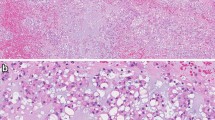Abstract
A 63 year old male presented with a three month history of dysphagia, neck swelling and an oropharyngeal swelling on examination. Initial fine needle aspiration cytology and magnetic resonance imaging (done at a peripheral hospital) suggested a salivary gland neoplasm with lymph node metastasis. An infra-temporal approach was employed to excise the tumour mass and a modified radical neck dissection undertaken to remove the cervical metastasis. Histopathological examination with immunohistochemistry confirmed this to be a soft tissue chordoma. To the best of our knowledge, this is the first documented report of an extra-axial soft tissue chordoma presenting with synchronous metastatic disease. Though rare, this adds to the list of differential diagnoses for complex parapharyngeal lesions. A multidisciplinary approach between head and neck surgery, histopathology, radiology and sarcoma teams is paramount for arriving at the correct diagnosis and to deliver optimal treatment.




Similar content being viewed by others
References
Tirabosco R, Mangham DC, Rosenberg AE, Vujovic S, Bousdras K, Pizzolitto S, et al. Brachyury expression in extra-axial skeletal and soft tissue chordomas: a marker that distinguishes chordoma from mixed tumor/myoepithelioma/parachordoma in soft tissue. Am J Surg Pathol. 2008;32:572–80.
Mirra JM, Nelson SD, Della Rocca C, Mertens F. Notochordal tumours. In: Fletcher CD, Unni KK, Mertens F, editors. Pathology and genetics of tumours of soft tissue and bone. World Health Organization Classification of Tumours, vol. 5. Lyon: IARC Press; 2002. p. 316–7.
Guarino M, Ballabio G, Rubino B, Nebuloni M, Tosoni A. Soft tissue sacrococcygeal chordoma with intracytoplasmic filamentous inclusions. Pathol Res Pract. 2005;201:699–704.
Nguyen RP, Salzman KL, Stambuk HE, Ahuja AT, Harnsberger HR. Extraosseous chordoma of the nasopharynx. AJNR Am J Neuroradiol. 2009;30:803–7.
Kataria SP, Batra A, Singh G, Kumar S, Sen R. Chordoma of skull base presenting as nasopharyngeal mass. J Neurosci Rural Pract. 2013;4(Suppl 1):S95–7. doi:10.4103/0976-3147.116426.
Lynn-Macrae A, Haines GK III, Altman KW. Primary chordoma of the lateral nasal wall: case report and review. Ear Nose Throat J. 2005;84:593–5.
Loughran S, Badia L, Lund V. Primary chordoma of ethmoid sinus. J Laryngol. 2000;114:627–9.
Tao ZZ, Chen SM, Liu JF, Huang XL, Zhou L. Paranasal sinuses chordoma in pediatric patient: a case report and review of literature. Int J Pediatr Otorhinolaryngol. 2005;69:1415–8.
Gladstone HB, Bailet JW, Rowland JP. Chordoma of the oropharynx; an usual presentation and review of the literature. Otolaryngol Head Neck Surg. 1998;118:104–7.
Hampal S, Flood LM, Jones RA. Chordoma of the parapharyngeal space. J Laryngol Otol. 1992;106:549–52.
Thakar A, Tandon DA, Bahadur S, Yijayaraghavan M. Extranotochordal chordoma presenting as multiple neck masses: report of a case. J Laryngol Otol. 1993;107:942–5.
Saqi A, Livolsi V, Mandel SJ, Baloch Z. Cervical chordoma masquerading as a thyroid neoplasm: a case report. Diagn Cytopathol. 2005;32:296–8.
Bumber Z, Krizanac S, Janjanin S, Bilic M, Bumber B. Extranotochordal extralaryngeal chordoma: a case report. Auris Nasus Larynx. 2009;36:116–9.
O’donnell P, Tirabosco R, Vujovic S, Bartlett W, Briggs TW, Henderson S, Boshoff C, Flanagan AM. Diagnosing an extra-axial chordoma of the proximal tibia with the help of brachyury, a molecule required for notochordal differentiation. Skelet Radiol. 2007;36(1):59–65.
Lantos JE, Agaram NP, Healey JH, Hwang S. Recurrent skeletal extra-axial chordoma confirmed with brachyury: imaging features and review of the literature. Skelet Radiol. 2013;42(10):1451–9.
Lauer SR, Edgar MA, Gardner JM, Sebastian A, Weiss SW. Soft tissue chordomas: a clinicopathologic analysis of 11 cases. Am J Surg Pathol. 2013;37(5):719–26.
Samii A, Gerganov VM, Herold C, Hayashi N, Naka T, Mirzayan MJ, Ostertag H, Samii M. Chordomas of the skull base: surgical management and outcome. J Neurosurg. 2007;107(2):319–24.
Carstens PHB. Chordoid tumor: a light, electron microscopic, and immuno-histochemical study. Ultrastruct Pathol. 1995;19:291–5.
Miettinen M, Gannon FH, Lackman R. Chordomalike soft tissue sarcoma in the leg: a light and electron microscopic and immunohistochemical study. Ultrastruct Pathol. 1992;16:577–86.
Uhl M, Welzel T, Oelmann J, Habl G, Hauswald H, Jensen A, Ellerbrock M, Debus J, Herfarth K. Active raster scanning with carbon ions: reirradiation in patients with recurrent skull base chordomas and chondrosarcomas. Strahlenther Onkol. 2014;190(7):686–91.
Deraniyagala RL, Yeung D, Mendenhall WM, Li Z, Morris CG, Mendenhall NP, Okunieff P, Malyapa RS. Proton therapy for skull base chordomas: an outcome study from the university of Florida proton therapy institute. J Neurol Surg B Skull Base. 2014;75(1):53–7.
Dobashi Y, Suzuki S, Sugawara H, Ooi A. Involvement of epidermal growth factor receptor and downstream molecules in bone and soft tissue tumors. Hum Pathol. 2007;38(6):914–25.
Yang C, Schwab JH, Schoenfeld AJ, Hornicek FJ, Wood KB, Nielsen GP, et al. A novel target for treatment of chordoma: signal transducers and activators of transcription 3. Mol Cancer Ther. 2009;8:2597–605.
Zhang Y, Schiff D, Park D, Abounader R. MicroRNA-608 and microRNA-34a regulate chordoma malignancy by targeting EGFR, Bcl-xL and MET. PLoS One. 2014;9(3):e91546.
Kitamura Y, Sasaki H, Kimura T, Miwa T, Takahashi S, Kawase T, Yoshida K. Molecular and clinical risk factors for recurrence of skull base chordomas: gain on chromosome 2p, expression of brachyury, and lack of irradiation negatively correlate with patient prognosis. J Neuropathol Exp Neurol. 2013;72(9):816–23.
Author information
Authors and Affiliations
Corresponding author
Rights and permissions
About this article
Cite this article
Khurram, S.A., Biswas, D. & Fernando, M. A Parapharyngeal Soft Tissue Chordoma Presenting with Synchronous Cervical Lymph Node Metastasis: An Unusual Presentation. Head and Neck Pathol 10, 400–404 (2016). https://doi.org/10.1007/s12105-016-0712-y
Received:
Accepted:
Published:
Issue Date:
DOI: https://doi.org/10.1007/s12105-016-0712-y




